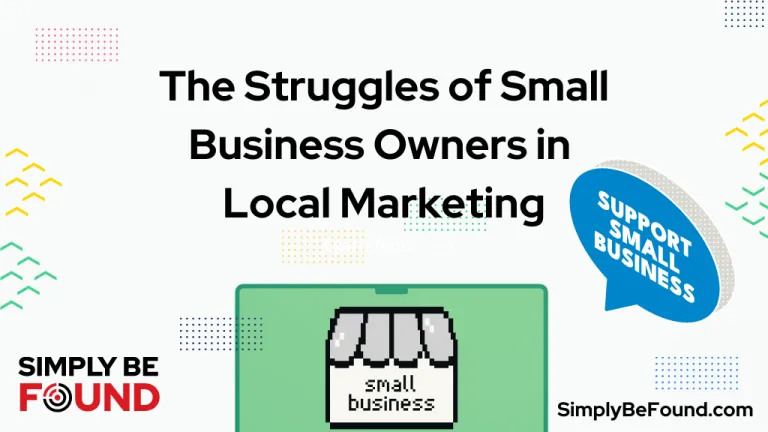Last Updated on: 4th April 2023, 10:36 am
Small business owners have a lot on their plates. From managing their finances to keeping up with inventory, there never seems to be enough time in the day. But one area that can often be overlooked is local marketing – the process of promoting your business within your community.
Local marketing can be crucial for small businesses, as it allows them to reach potential customers who live nearby and build relationships with other businesses in the area. However, it can also present unique challenges that larger companies may not face.
One major struggle for small business owners when it comes to local marketing is simply getting noticed. With so many other businesses vying for attention, it can be difficult to stand out from the crowd. This is especially true if you don’t have a big advertising budget or a well-known brand name.
Another challenge is figuring out which marketing tactics will work best for your particular business. Should you focus on social media? Print ads? Word-of-mouth referrals? Each approach has its own benefits and drawbacks, and what works for one business may not work for another.
Even if you do manage to get noticed and attract new customers, retaining them can be another struggle altogether. Small businesses often operate on tight margins, which means they may not have the resources to offer extensive loyalty programs or discounts as larger companies do.
What Can Small Business Owners Do to Overcome Local Marketing Challenges?
Identifying Target Audience
Small business owners can overcome local marketing challenges by effectively understanding and addressing their target audience’s needs and preferences. This involves a multi-step process that includes identifying the target audience, conducting market research, and implementing strategies to reach potential customers effectively.
- Identify your target audience: Small business owners should start by defining their ideal customer base. This could include factors such as age, gender, income, location, and interests. Identifying the target audience is crucial in tailoring marketing efforts to attract and retain these customers.
- Conduct market research: To better understand the target audience and the local market, small business owners should conduct market research. This can involve analyzing competitor strategies, identifying trends and patterns, and gathering insights into the preferences and behaviors of potential customers. Market research can be conducted through online tools, surveys, or by hiring a professional research agency.
- Engage with customers through surveys and focus groups: Small business owners can directly reach out to customers or potential customers through surveys and focus groups. These methods allow for the collection of valuable feedback and insights, helping businesses refine their marketing strategies and make informed decisions. Surveys can be distributed through email, social media, or in-person, while focus groups can be organized with a select group of customers to discuss specific aspects of the business.
- Create targeted marketing campaigns: Based on the gathered information, small business owners can create targeted marketing campaigns that cater to the specific interests and preferences of their target audience. This may involve using personalized messaging, promotional offers, and tailored content to engage and attract customers.
- Utilize local marketing channels: To enhance local marketing efforts, small business owners should explore various channels such as local newspapers, radio stations, community events, and online platforms like Google My Business and social media. By leveraging these channels, businesses can increase visibility and engage with their target audience effectively.
- Collaborate with other local businesses: Small business owners can collaborate with other local businesses to create joint marketing efforts or cross-promotional campaigns. This can help extend the reach of their marketing initiatives and foster relationships within the community.
- Monitor, measure, and adapt: Finally, it’s essential to continuously monitor the success of local marketing campaigns and adjust strategies as needed. Small business owners should track key performance indicators (KPIs) such as customer engagement, sales, and conversions to evaluate the effectiveness of their marketing efforts and make data-driven decisions for improvement.
Partnering with Other Local Business
Partnering with other local businesses or organizations can help small business owners overcome local marketing challenges by pooling resources, increasing visibility, and attracting a broader audience. Collaborative marketing efforts can be a cost-effective and efficient way to build brand awareness and generate more sales.
- Identify potential partners: Start by identifying businesses or organizations in your area that share a similar target audience or complement your products or services. Look for non-competing businesses that can help create mutually beneficial marketing opportunities.
- Establish relationships: Reach out to potential partners and establish a rapport. Attend local networking events, join business associations, or participate in community gatherings to connect with other business owners and organizations. Building relationships is essential in creating successful partnerships.
- Develop joint marketing campaigns: Collaborate with your partners to create joint marketing campaigns that benefit both parties. These can include co-branded advertisements, shared social media content, or combined email marketing efforts. By working together, you can maximize your reach and create a more significant impact on your target audience.
- Co-host events: Partner with other businesses or organizations to co-host events, such as workshops, seminars, or product launches. Joint events can help you pool resources, share costs, and increase attendance, leading to a more successful outcome for all involved.
- Offer joint promotions: Create special offers or discounts that involve both your business and your partner’s products or services. For example, a coffee shop could partner with a local bookstore to offer a discount on coffee when customers purchase a book or vice versa. Joint promotions can encourage customers to engage with both businesses, increasing sales and customer loyalty.
- Cross-promote each other’s businesses: Leverage each other’s customer base and online presence to cross-promote products or services. This can involve displaying promotional materials at each other’s locations, sharing social media posts, or including information about your partner’s business in your newsletters.
- Collaborate on community projects or sponsorships: Work together with other local businesses or organizations on community projects or sponsorships. This can help increase your visibility in the community and demonstrate your commitment to supporting local initiatives.
- Evaluate the success of partnerships: Track the performance of your joint marketing efforts to determine their success. Assess key metrics such as customer engagement, sales, and overall return on investment (ROI). Use this information to refine your strategies and continue building successful partnerships.
Word-Of-Mouth Referrals
Personal connections and word-of-mouth referrals can be instrumental in overcoming local marketing challenges for small business owners. Positive experiences and recommendations from satisfied customers can build trust, credibility, and brand loyalty, which in turn can lead to increased visibility and new customers.
- Prioritize customer experience: Focus on providing exceptional customer experiences by offering high-quality products or services, personalized attention, and excellent customer support. Satisfied customers are more likely to share their positive experiences and recommend your business to others.
- Encourage customer feedback: Make it easy for customers to provide feedback, both positive and negative. This can be done through comment cards, online surveys, or direct communication. By understanding and addressing customer concerns, you can continuously improve and enhance their overall experience.
- Request online reviews: Encourage satisfied customers to leave positive reviews on platforms such as Google, Yelp, or social media. Online reviews are often one of the first things potential customers see when searching for local businesses, so having a strong presence can significantly impact your visibility and reputation.
- Offer referral incentives: Implement a referral program that rewards customers for recommending your business to their friends and family. Incentives can include discounts, free products or services, or loyalty points. This can motivate customers to spread the word about your business and help you attract new clients.
- Engage with customers on social media: Maintain an active presence on social media platforms and engage with your customers by responding to their comments, questions, or concerns. This can help build personal connections and demonstrate your commitment to customer satisfaction.
- Leverage testimonials: Collect and showcase customer testimonials on your website, social media, or in-store displays. Testimonials can provide social proof of your business’s quality and encourage potential customers to choose your products or services.
- Network within the community: Attend local events, join business associations, or participate in community projects to build personal connections with other businesses and individuals. Networking can help you establish a strong presence in your area and increase the likelihood of receiving word-of-mouth referrals.
- Train employees to be brand ambassadors: Educate your employees on the importance of personal connections and word-of-mouth marketing. Encourage them to share their positive experiences with your business and provide exceptional customer service to support the growth of your reputation.
Small business owners can tackle local marketing challenges by creating focused campaigns, partnering with local businesses, and using personal connections and word-of-mouth referrals. These methods help attract more customers, build strong relationships, and promote business growth. By working together with other businesses and valuing customer feedback, small business owners can boost their visibility and achieve lasting success.
Takeaway
In conclusion, while local marketing may present unique challenges for small business owners, it’s also an essential part of building a successful enterprise within your community. By taking the time to understand your audience and collaborating with others in your area, you can overcome these obstacles and thrive as a local entrepreneur.







